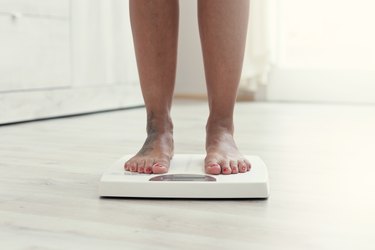How Do Taylor Body Fat Scales Work and the Steps to Set One Up

Francesco Carta fotografo/Moment/GettyImages
If you’re looking for a new scale to weigh yourself at home, you might consider one from Taylor Precision Products. The company makes a variety of scales, including models that analyze your body fat percentage.
Here’s how body fat scales work: A technology called bioelectrical impedance analysis allows them to determine the amount of fat you carry, as opposed to lean mass, according to Houston Methodist.
Video of the Day
Video of the Day
But because any at-home scales comes with a slight margin of error, it’s crucial you only use a body composition scale for a general estimate. And if you’re searching for what’s a happy weight range for your body, make an appointment with your physician.
Taylor offers several body composition scales, including:
- Taylor Bluetooth Smart Body Composition Scale, with AIFIT App ($39.99, Taylor)
- Taylor Precision Products Body Composition 400lb Bathroom Scale ($39.99, Amazon)
- 5737F Taylor Body Composition Scale ($33.27, Amazon)
- Taylor Precision Products BIA Digital Bathroom Scale ($36.29, Amazon)
- Taylor Precision Products 400 Lb. Capacity Digital Glass Platform Body Composition Analyzer Bath Scale ($18.79, Amazon)
Are Taylor Body Fat Scales Accurate?
If you want convenience in a body fat scale, the Taylor models work well enough.
But, “these devices aren’t extremely accurate,” says Nicole Hinckley, RD, LD, registered dietitian and owner of Blissful Nutrition. “Body composition scales provide a rough estimate of a person’s body fat percentage and different substances in the body — and with this information, plus your age, weight, height and sex, it formulates an estimate,” Hinckley says.
The key word there might “rough.” All sorts of factors — including your hydration level — will affect the accuracy of a body composition scales, according to Houston Methodist. Dehydration will lead to a lower body fat reading, for instance. Edema can also be a factor, per Houston Methodist.
The most accurate way to measure body composition is a DEXA scan, which is a bone scan that uses X-ray technology to check strength and density, according to the Mayo Clinic. Of course, that’s not a very accessible option — for a simple at-home option to know your weight, if not your body composition, you can turn to the most accurate scales for body weight.
Warning
Keep in mind, there are some groups of people who should not use at-home body scales, like those with pacemakers or heart implants, as the BIA technology from the scale can interfere with the pacemaker’s effectiveness, per the American Heart Association. Talk to your doctor before using a body fat scale, to see if it’s safe for you.
How the Taylor Body Fat Scale Works
Understanding how your scale works will give you a better idea of how to operate it.
When you stand on the scale, two electrodes positioned under each foot transmit a harmless, low-level electrical current through your body. The signal passes through lean mass quickly, while fat slows the current down, allowing it to estimate how much of your body is fat and what portion is lean mass.
That’s a metric that can be meaningful, because people with obesity (aka excess body fat) are at higher risk for heart disease, type 2 diabetes and certain cancers, per the Centers for Disease Control and Prevention (CDC). Measuring your body fat in relation to lean mass is a good way to assess your health and nutrition.
You Can Use Your Taylor Scale With an App, Too
The 7222F Taylor smart scale syncs with an app. While the company recommends their free SmarTrack app, you can use the scale with another fitness app if you’d prefer. Set up a Taylor scale account just the way you would with any other app by downloading it and following the instructions. Most mobile devices (both iOS and Android products) are compatible with this smart scale.
How Do You Program a Taylor Body Fat Scale?
Taylor body fat scales typically come with batteries. To get started using yours, flip it over and remove the plastic slip sticking out of the compartment (the slip is in place to prevent the batteries from draining while at the warehouse and during shipment). If there isn’t a plastic slip, your model may not have batteries included, which means you’ll have to purchase them separately.
To program your Taylor body fat scale, follow these steps, according to the Taylor website:
- Press the power button so it brings up the height screen.
- Enter your size and then continue to the age, gender and other options. Add each one and following the up arrow until you see a 1, the memory number.
- Hit set again and the scale should be programmed.
Multiple people can use a single scale. Use the slots — labeled P0, P1 and so on — to enter personal details for each individual. Once you hit set, the information is saved.
A note on language: While we use the word “sex” (not “gender”) when referring to biological characteristics, we are opting to use the language from the scale’s manufacturer to avoid confusion while programming the scale.
How Do You Calibrate Your Taylor Scale?
Fortunately, the Taylor scale is calibrated for accuracy already, so you don’t need to fiddle with it at home. That said, sometimes shipping causes issues, in which case you’ll need to initialize the scale, per Taylor. Here’s how:
- Put the scale on a hard surface floor (note: avoid carpeted floors or any uneven surfaces)
- Put one foot on the scale, pressing down just enough for the display to show either zeroes or dashes.
- Remove your foot once you see zeroes or dashes on the display, then wait for the scale to turn off.
- Step up onto the scale for a weight.
Tip
If you store your scale vertically, you may need to initialize it before your next use. Your best bet: Store the scale flat, per Taylor.
You may sometimes find that if you weigh yourself twice, the reading will be slightly different. If the two weights are within two pounds of each other (or within 1 percent for weights over 200 pounds), the scale is working properly. If there’s a bigger discrepancy, it may be that the scale was damaged, either before purchase or during use, or that it’s resting on an uneven surface or carpet, per Taylor.
Calculating Your Body Fat
Follow these steps to calculate your body fat using the scale, according to Taylor:
- Before you begin, remove your shoes and socks and wipe your feet with a damp cloth.
- Switch the power on.
- Press the up or down arrow to navigate to your personal memory number.
- Once the scale displays “0.0,” place each foot on top of the electrodes, standing as still as possible. After a few seconds, the display will show your weight.
- Remain on the scale; the upper portion will show “—” while it computes other measurements. After a few seconds, it will display your body fat and water percentage.
Note: The measurements will repeat five times for convenience, giving you time to write them down, if you like.
How to Read Your Taylor Body Fat Scale
Hinckley recommends weighing yourself at few times a week so you can note whether some weight is just temporary or not.
“If you see the scale go up momentarily, it’s probably just due to sodium or inflammation,” she says. But if stepping on the scale becomes a negative experience, definitely stop. “If you’re discouraged when you’re on the scale, check to see how your clothes are fitting or consider taking your measurements,” she says.
And it’s a good idea to learn the best time to weigh yourself, too. Per the Taylor user manual, the most consistent way to read the scale is at the same time of day and under the same conditions, say, in the morning, naked. The scale also works as a regular scale that measures only weight. For this, just turn the scale on and stand on it, waiting a few seconds for your weight to appear.
How to Reset Your Taylor Body Fat Scale
If things go wrong with your scale, it may leave you wondering why your Taylor scale isn’t working. Fortunately, as with many electric scales, Taylor scales have error messages to offer feedback — Error 1, for instance, indicates that the scale isn’t stable, and you should check that the surface is even and not a rug or carpet.
Other errors will pop up if your feet aren’t damp enough for the body fat reading, your feet aren’t big enough to reach the sensors or the body fat or water percentage numbers are out of range for the scale.
If you receive an error message — or the scale behaves oddly — a good first step is to reset the scale, which you can do by following these steps, per Taylor:
- Remove the battery.
- Place the scale on a hard and flat surface (no rugs or carpets).
- Stand still on it for 5 seconds and then step off.
- Put the battery back in.
- While being sure to be on a smooth floor, place just one foot on it so it displays zeroes or dashes.
- Remove your foot.
- Wait for the scale to turn off and then mount it again. If the reset worked, you should see your weight right away, but if this isn’t the case, a call to customer service may be next or you can reset it a second time.
Why Does Your Digital Scale Give Different Readings?
Check the error messages discussed above in case you’re making a mistake with the scale, it needs to be reset or your numbers are too high to register.
Hinckley notes that body composition scales are designed to provide only a rough estimate of your body fat percentage, adding that “in studies, these smart scales were reasonably accurate for weight but not that precise for body composition.”
Bottom Line: Are Body Fat Scales Worth It?
They can be.
“If you’re going to get on a scale it can be helpful to see if your body composition is changing,” Hinckley says. It can be discouraging to see the number go up or plateau, even if you’re losing body fat and gaining muscle, she adds. With a body fat scale, these body composition changes are more apparent.
But keep in mind that body composition scales are only providing a rough — not precise — estimate of your body fat, as Hinckley mentioned. In general, these scales may be more likely to overestimate body fat percentage, according to the Cleveland Clinic.




